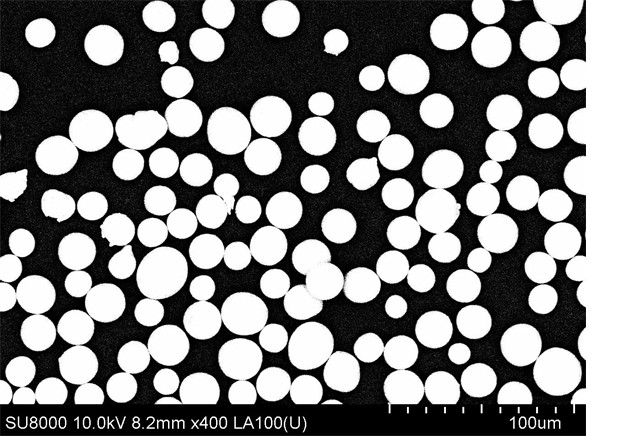Resonac Automates Material Inspection by Utilizing Deep Learning-Based Image Analysis
July 12, 2023
Resonac Holdings Corporation
By utilizing deep learning*1 and image analysis— technologies which have been making remarkable progress in recent years—for material inspection, Resonac Corporation (President: Hidehito Takahashi) has succeeded in automating product development and inspection, and in significantly reducing the time required for inspection. For example, the inspection time for solder particles used in anisotropic conductive film can be reduced to 1/140th of the time it previously took, while the inspection time for graphite fiber used as a conductivity aid for cathodes and anodes of lithium-ion secondary batteries can be reduced to 1/3rd of the conventional time.
The inspection processes for solder particles and graphite fibers typically consisted of visual inspections. Issues included the fact that it was time-consuming, involved many processes, and there were variations in the amount of time it took for different inspectors to perform the inspections. Meanwhile, automating the inspection processes using deep learning required having a vast number of images that would make up the basis for learning, engineers specializing in deep learning, and computers with powerful data processing capabilities.
The team of Research Center for Computational Science and Informatics which is dedicated to development of the image analysis system, succeeded in automating material inspections by leveraging the capabilities of a team specialized in deep-learning-based image analysis and introducing unique technologies. In the development process, the team 1) introduced advanced image processing technology that enables the system to learn and perform analysis using just a small number of images, 2) narrowed down the deep learning areas to be used for inspection, and 3) introduced a web application. The team also communicated closely with those who would actually perform the work on the manufacturing floor and prepared high-quality images for deep learning. This automated material inspection, and simultaneously eliminated the variations in the amount of time it took for different inspectors to perform inspections.
In order to obtain highly accurate results, we have developed a number of unique innovations, such as combining conventional image processing techniques with deep learning based on its operating principles and combining multiple deep learning models.
Going forward, the Research Center for Computational Science and Informatics plans to increase the number of engineers capable of performing image analysis by developing in-house expertise in image analysis, and develop intra-company web applications that utilize image analysis and large language models.
(1)This image processing technology enables learning and analysis using just a small number of images.
While deep learning typically requires thousands of images as a basis for learning, we can now use deep learning with as little as a few dozen images. This is possible due to a technique that allows us to obtain multiple images from a single image*2 and then transfer learning to a model that has already learned from other data is tuned using the target data.
(2)Narrowing down the deep learning areas to be used for inspections
While it typically takes time to train engineers specializing in deep learning, the range of operations used in materials inspection is limited, so we were able to train engineers quickly by focusing on technologies for analyzing three essential areas (calculation, measurement, and classification).
(3)Web application deployment
We have created a setup where deep learning calculations are performed on a high-performance server in the cloud, and provided users with a web application connected to the cloud server through a network, thereby enabling users to conduct image analysis on a business-use mobile PC.
We also facilitated maintenance and management work on the part of software developers with the use of cloud.


Solder particles: The photographed image is analyzed, and the quantity, dimension, and roundness of the particles on the screen are measured automatically.


Graphite fibers: The photographed image is analyzed, and each fiber is identified separately.
(Even where fibers overlap, they are not misidentified as the same fiber.)
*1. Deep learning: A method used to teach artificial intelligence (AI) how to process information.
*2. Multiple images are obtained by making adjustments to a single image, such as left-right inversion, saturation, etc.
For further information, contact
Public Relations Group, Brand Communication Department
